In the natural world, insects are diverse in species as well as shapes and sizes. Around our daily life we often encounter small insects but there are also larger species. Have you ever seen the largest insects in the world? Let's learn about these giant insects with Toplist.
Titanus Giganteus
Titanus giganteus is a species of barber beetle. It is one of the longest beetle species, but excluding the length of the horns, it is the longest beetle. Adults can be up to 16.7 cm long.
Of the known beetles, only the 17.7 cm long male Dynastes hercules is longer than this species, but excluding the horn length, this species is longer than Dynastes hercules. It has a pair of short, curved and sharp claws that can bite a pencil in half and bite through human flesh.
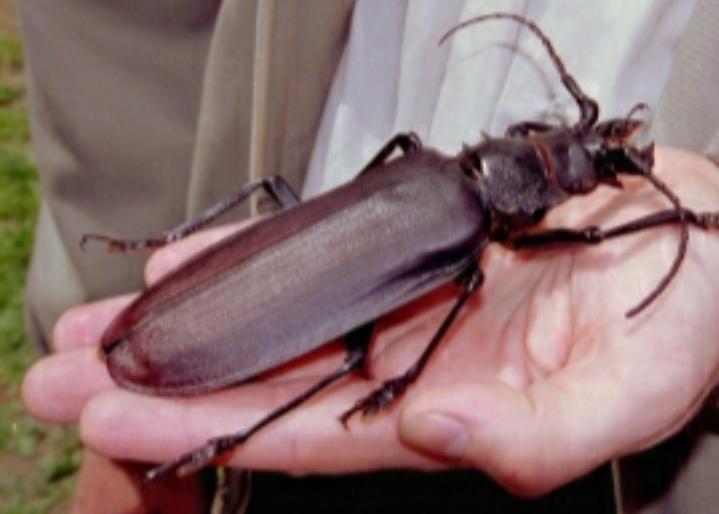
Chinese mantis
The Chinese mantis (Scientific name Tenodera sinensis) is a species of mantis native to China and introduced to North America around 1895 as a source of pest control. Since then, they have spread throughout much of southern New England, and the northeastern United States. Adults up to 10 cm long, the largest mantis in North America, this species is often misnamed Tenodera aridifolia sinensis.
The Chinese mantis' diet consists mainly of other insects, although adult females can sometimes eat small vertebrate prey such as reptiles and amphibians. Like some other mantises, they are cannibals. The females can produce a hard nest the size of a ping pong ball, which can hold up to 200 eggs. This nest is usually attached to trees such as shrubs and small trees. Their coloration ranges from green overall to brown to green horizontal stripes on the edges of the forewings.
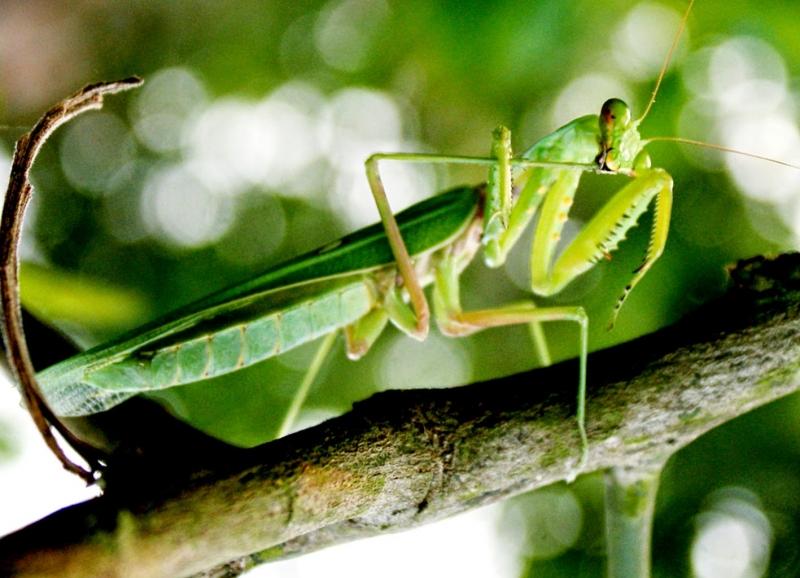
Butterfly Queen Alexandra
The Queen Alexandra butterfly, distributed mainly in eastern Papua New Guinea, is the largest butterfly in the world. The wings of the male butterfly are also brown but with iridescent blue and green markings, and the abdomen is bright yellow. A special feature to recognize male butterflies is the golden spots on the back of the wings.
Female Alexandra Birdwing butterflies are usually larger than males with wider and more rounded wings. The female butterflies can reach a wingspan of up to 31 cm, a body length of about 8 cm and a mass of up to 12 grams, the measurements of a very large butterfly. Females have brown wings with white markings, a cream-colored body, and a small portion of the thorax with red feathers. Males are smaller, the wings are usually also brown, but there are also markings of green or pale yellow. The wingspan of the male butterfly is about 16 - 20 cm. A distinctive feature of the morphology of the male butterfly is the yellow spot on the hindwing.
Female Alexandra Birdwing butterflies lay about 27 eggs in their lifetime (this is based on anatomical results of the mother butterfly performed by Ray Straatman). Newly hatched larvae will eat their own eggshells before continuing to develop with fresh leaves. The moth larvae are black with red spots and have a small cream-colored band in the middle of the body.
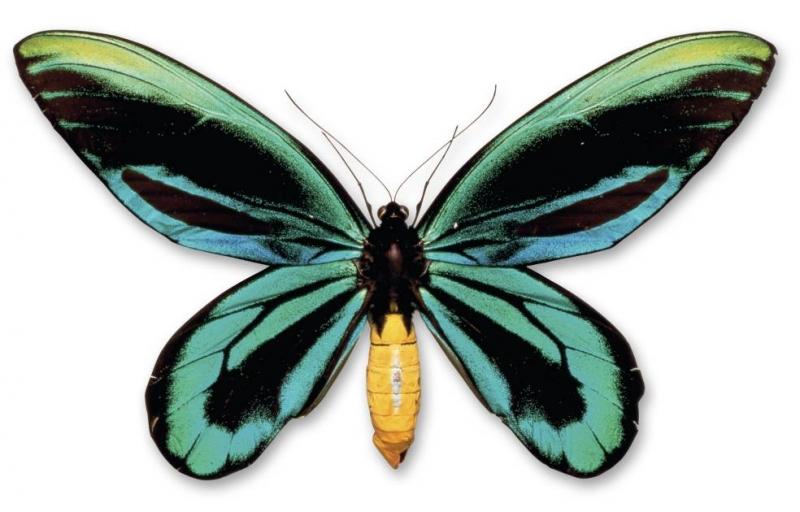
Giant Long-Legged Katydids
This species, scientifically known as Arachnacris corporalis, is a species of grasshopper native to Malaysia. Their average length at maturity ranges from 15 to 25 cm. They are usually green in color with a pair of webbed wings and a green upper wing that looks like a leaf, a pair of long thin antennae on the top of the head, and six pairs of long legs.
Giant Long - Legged Katydids range in size from as small as 5 mm to as large as 250 mm. Smaller species often live in drier or more stressful environments which can lead to their small size. Small size is associated with greater agility, faster growth and lower nutritional requirements. Giant Long - Legged Katydids are arboreal insects most commonly heard at night during summer and early fall. They can be distinguished from grasshoppers by the length of their antennae, which can exceed the length of their body, while the antennae of grasshoppers are always relatively short and thick.
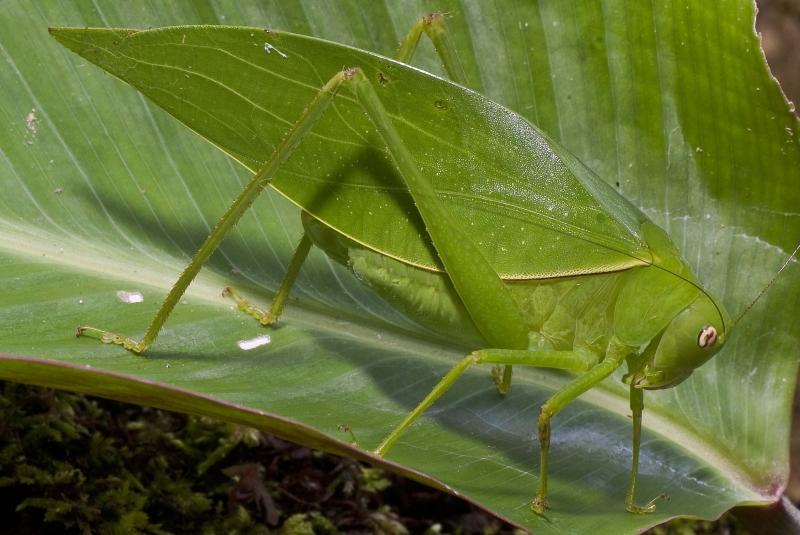
Megasoma Elephas
This beetle belongs to the subfamily Dynastinae and is common in the rainforests of Mexico, Central America and South America. The length of an adult male is 7 - 12 cm and they are usually twice as large as the female. They are usually black in color and covered with a soft coat. The feathers grow very thick on their beetle wings, which also gives them a yellowish appearance. Males have two horns on their heads and one horn on the anterior thorax used for defense and competition, while females have no horns.
Megasoma elephas are usually black and covered with a soft coat. The feathers grow especially thick on their beetle wings. This coat also gives them a slightly yellow appearance. Males have two horns on the head and one on the anterior thorax, while the female has no horns. Horns are used for self-defense, or to compete with each other over food and mating.
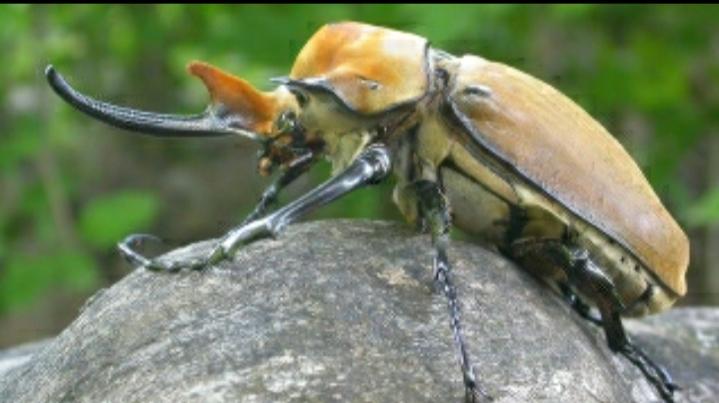
Goliathus
This beetle, scientifically known as Goliathus goliatus, is a genus of beetles in the family Scarabaeidae. They are one of the largest species of the genus Goliathus with a body length of about 60 - 110 mm for males, 50 - 80 mm for females and can reach weights of up to 80 - 100g. Their anterior thorax is predominantly black, with white longitudinal stripes, while the beetle's wings are usually dark brown.
This species has a pair of relatively large membranous wings used for flight. When not in use, they are stowed under the beetles. Their heads are white, with a black Y-shaped horn in males used in battles for food or mates with other males. The Goliathus beetle mainly feeds on tree sap and fruit.
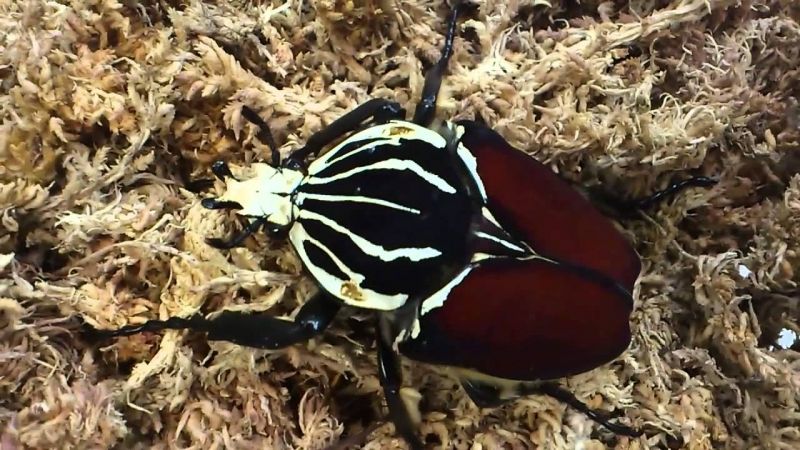
Giant burrowing cockroach
The giant burrowing cockroach is also known as the rhinoceros cockroach, the Queensland giant cockroach and the stink bug. These cockroaches are native to Australia and are mainly found in tropical regions of Queensland. They are the heaviest cockroaches in the world and can weigh up to 35 g and reach up to 8 cm in length. Unlike most egg-laying insects, the giant female cockroach gives birth to her young and protects her offspring in underground alleys, providing them with leaves she gathers overnight. They can live up to 10 years, unlike some other cockroaches, they have no wings and are not considered pests. Cockroaches play an important part in the ecosystem by consuming dead leaves, especially eucalyptus, and recycling other matter.
As their name suggests, they can dig into the ground to a depth of about 1 m, where it makes a permanent home. Adult males and females can be distinguished by the size of the "spoon" on the proboscis, which covers the head, males have a much more pronounced spoon. They grow by shedding their outer shell 12 or 13 times before reaching full size. When a cockroach molts, it will appear pure white except for the eyes.
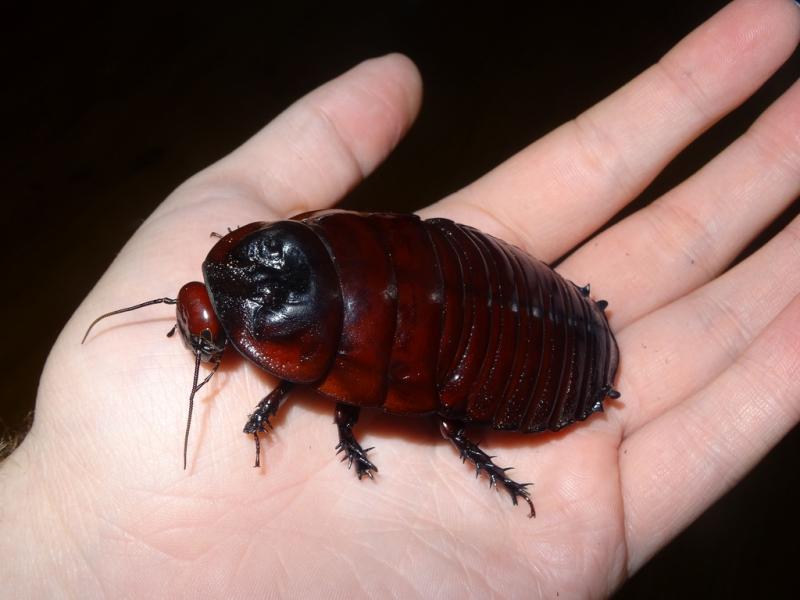
Giant camel spider
Camel spider's scientific name is Arachnid Solifugae, also known as Wind Scorpion. They belong to the family of hairy spiders and live mainly in the desert. They have 6 pairs of legs of all shapes and sizes. Their body length can be up to 15 cm with a weight of about 56g, so people often call them giant spiders. In particular, this spider has the ability to move very quickly with a speed of up to 50 km / h and can jump up to 2m high. That is why camel spiders are a terror to all animals in the desert. They usually hunt alone seasonally and at night.
Camel spiders are small compared to many other species, but they are quite aggressive predators. Due to their high metabolic rate, they have to eat a lot and actively hunt. Camel spiders are non-venomous but very fast and strong with scissor-like molars. The act of burrowing is typical behavior of this species when it feels threatened.
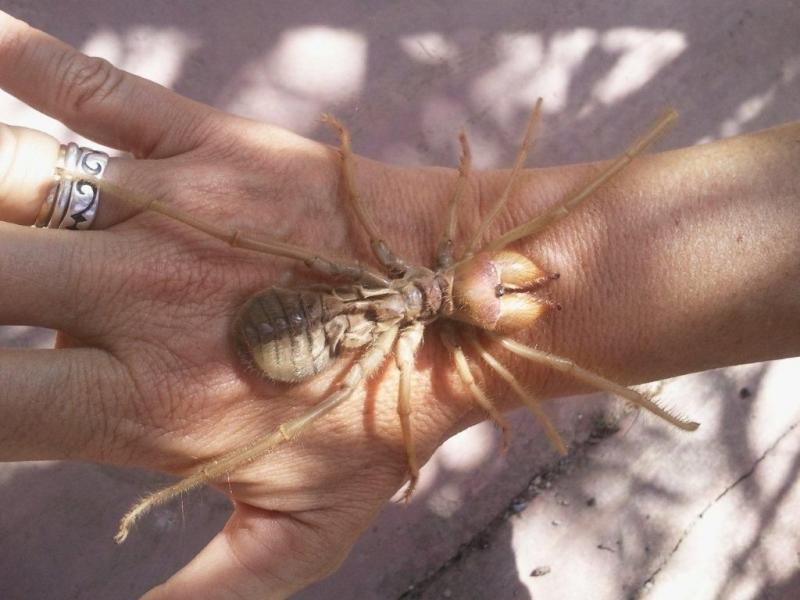
Giant Weta Cricket
This giant Weta cricket has the scientific name Deinacrida, originating from New Zealand and is considered an endemic species of this country. Weta crickets are also one of the "giant" insects. Excluding the length of the legs and antennae, the body of each Weta cricket is already 10 cm long. Their weight can be up to 70 - 80 grams, 100 - 150 times larger than flies and three times heavier than a mouse. The name Weta is derived from the way the people of the Maori tribe call this insect - Wetapunga, which means God of ugly things.
The special thing about this cricket is that during 200 hundred million years they have almost no evolution at all. Their shape is almost kept intact until now. Weta crickets are also classified by biologists as the most aggressive species in the world. They can repel mice and bite humans. However, this only happens when they feel threatened.
The weta cricket has been recognized as the heaviest insect ever found. Weta crickets are only found on New Zealand's Little Barrier Island, although there are 70 other species of weta crickets around the country. The giant Weta crickets lost their inland habitat because their predators were rats that were accidentally brought here by Europeans. The funny thing is, even though an insect like the Weta cricket can't fly, they can't even jump like other species.
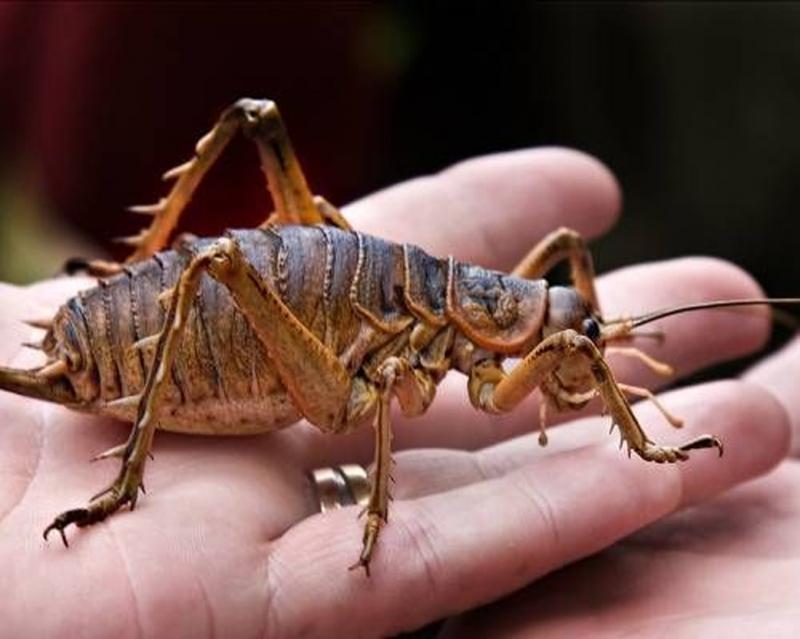
Star moth (Atlas moth)
Moths are an insect closely related to butterflies, they belong to the Order Scales. Moths make up the majority of the species species in this order, thought to contain between 150,000 and 250,000 different species of moths (about ten times the number of diurnal species), with thousands more undescribed. run out of.
The Atlas moth, also known as the Atlas moth, has the scientific name Attacus atlas. They are moths of the family Monarch, commonly found in tropical and subtropical forests of Southeast Asia, common in the Malay Archipelago. The Atlas moth is considered the largest moth in the world and has a total wing surface area of about 400 cm2. Their wingspan is also among the largest, from 25 - 30 cm. Females are larger and heavier. The starfruit butterfly is one of three species of butterflies listed in the Vietnam Red Book (starfruit butterfly, long-tailed butterfly, and phoenix butterfly).
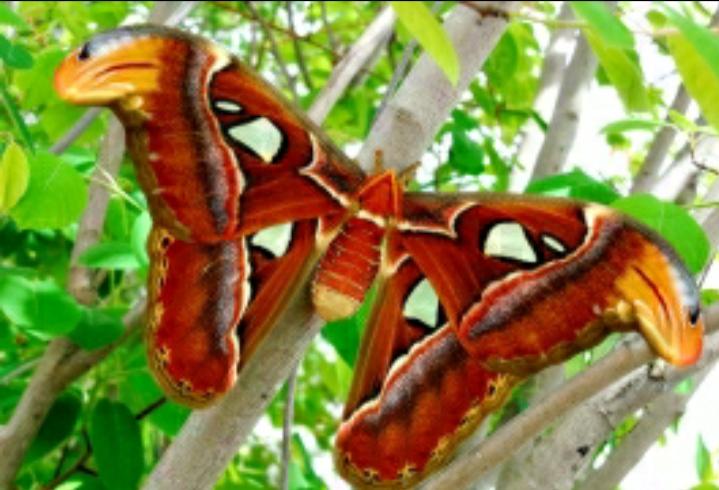
Large insects make us feel very scary, but not all insects are harmful. They are also a colorful part of nature, of everyday life for us.




















